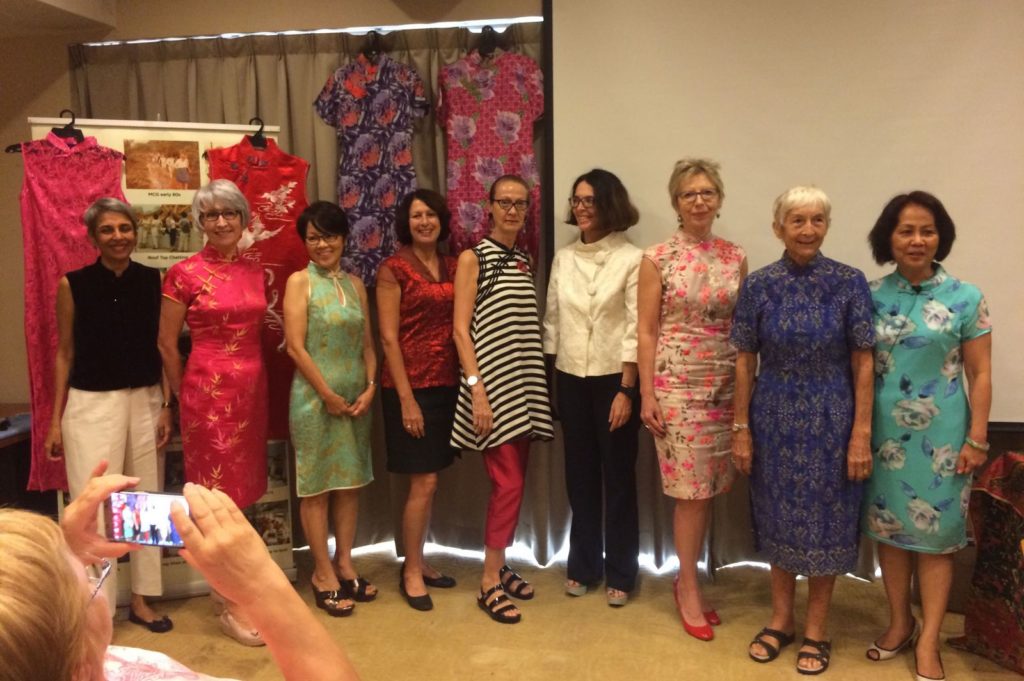
Clothes make the man or the woman for that matter. More often than not the clothes we wear reflect our cultural heritage. This observation is amply evident in multiracial Malaysia where we live. While the Malays sport a garment called the Baju Kurung, the Indians don colorful sarees, the Chinese, at least for formal and dressy occasions wear their version of the little black dress, the rather constricting but immensely beautiful, close-fighting dress, the cheongsam.
To enlighten us about the origins and significance of the cheongsam, which down the years has also been called the ‘Suzy Wong,’ was Janet Tee Siew Mooi, a former deputy-director at the Muzium Negara, and a director at National Textile Museum.
Our members at the Malaysian Culture Group are a style conscious bunch, and such was the level of enthusiasm and interest in the lecture that more than half a dozen of our ladies came dressed in slinky cheongsams to set the mood for the talk. Janet too was wearing an attractive, patterned, daywear cheongsam but unfortunately for her, car troubles en route to the event coupled with an uncooperative laptop had her slightly flustered.
However, she gamely soldiered on despite the interruptions and used a series of slides to tell us about the history of the cheongsam, a garment which first emerged during the reign of the Qing dynasty amongst the Manchu people. Both males and females during this period wore a one-piece dress called the ‘Qipao.’ The Manchu noblemen readily adopted the qipao, and it was soon made mandatory for the Han Chinese women.
Thus, began the evolution of the garment, which soon came to be seen as a symbol of female emancipation as celebrities and socialites eagerly embraced the snug-fitting mandarin-collared dress, which was fashioned out of luxurious fabrics and had slits of varying lengths.
The portage of the cheongsam reached its zenith in the 1920’s and 30’s, an era during which Shanghai came to be known as the ‘Paris of the East’ for its glamorous and hedonistic lifestyle.
The popularity of the cheongsam waned in China during the Mao years, but the Shanghainese tailors who fled to Hong Kong during the 1950’s brought the style with them. The cheongsam soon crossed over to Malaysia and came to be popular as workwear in the early 1950’s and 60’s. In the 1960’s Malaysia, when actor P.Ramlee and his wife Saloma were all the rage, the cheongsam acquired a distinct Malaysian flair. Local fabrics including the mass produced batik, songket and even printed georgette and chiffon, were used to make the cheongsam. Ladies also paired their cheongsams with jackets to ward off the chill in an air-conditioned office as the cheongsam continued to change and evolve with the times.
Janet further enlightened us on the various details of this enchanting garment. She drew our attention to the garment’s intricate flower buttons, which are now a novelty as they are difficult to produce. Concealed zips that are much more convenient in modern times have now replaced these flower buttons in most cheongsams, making them merely ornamental.
Janet went on to add that modern-day cheongsams have varied sleeve and slit lengths though the cheongsam, nowadays has come to adopted as a uniform for various airline staff, besides featuring prominently in movies and beauty pageants as a symbol of Chinese identity.
At the end of the talk, Janet called upon our cheongsam and deconstructed cheongsam-wearing members to come up in front for a photo opportunity. We then left the Meritz function room with a greater understanding and appreciation for the alluring garment, that is the cheongsam.
Text by Anjeeta Nayar
September 2016
